An easy and delicious cheese plate appetizer is perfect for a party, holiday entertaining, and any get-togethers! In this step-by-step tutorial, I'll show you how to make an amazing cheese plate every time.
Let's talk about CHEESE!
A cheese plate appetizer is an essential dish at 99% of my gatherings, holiday or otherwise. (It's also been an essential dish on, y'know, Tuesdays when I'm too lazy to cook dinner).
And yes - this post is titled "how to make a cheese plate," but you can follow these basic steps to make allllll kinds of party platters! Our cheese plate today has a bit of meat included (cheese and charcuterie FTW!) and I also like to round things out with crackers, fruit, sausage, or whatever seasonal produce I have on hand (more on that later!)
I'll cover things like building seasonal cheese plates, what to include on your cheese plate, and how to make a cheap cheese plate (because BUDGET) later on - but let's start with the ASSEMBLY. Cheese plates can look very proper and fancy, but I'm going to let you in on a secret: It is SO. EASY. to build a fancy cheese plate - you just need to follow this basic order of operations.
Don't be afraid to get creative and have fun with it - you're already on your way to making a perfect cheese plate every time!
PS - In a hurry? Use the links below to jump to a specific section of this post!
Jump to:
How to make a cheese plate step-by-step!
Let's break it down.
1. Start with the big items: bowls and cheese.

Start with the things that take up the most room on a cheese plate - you'll tuck everything else into the blank spaces later on!
A lot of people like to start with the cheese, but I prefer to start by placing some little bowls around my cheese board. Why? Because it helps me make part of the cheese plate ahead of time. If I know I'm making a cheese plate for a party, I'll set out the cutting board (I'm using a 15"-ish wood board from Target - it's no longer in stock but I found a similar one here) and place the bowls the night before so it's ready to go. You can skip the bowls if you like, but I like using them to hold dips and smaller items - plus, the height and round shape helps break up the cheese board to make it more fun to look at. (PS - Swap small store-bought jars of jam or honey, roasted red peppers, or pesto for the bowls here if you like!)
Next, add the cheeses. Cheese should really be served at room temperature, which means you should take it out of the fridge and let it rest for 30 minutes to an hour before serving (learn more in this post). You can do this two ways: One, take the cheeses out of the fridge, throw them on the counter, and come back later to add them to the cheese plate. Or two, unwrap and cut the cheeses straight out of the fridge, then place them on the cheese plate and let them come to temperature on the board (pro tip: cover the cheese with beeswax wrap or plastic wrap to prevent them from drying out).
I like to serve cheeses in a variety of shapes to add visual interest. Soft cheeses, like the brie and goat cheese in this photo, can be served as is. For hard cheeses, like the cheddar and parmesan, I prefer to cut them into slices or cubes and stack them up on the board - this makes it easier for guests to grab a piece without having to saw through a hard cheese with a cheese knife and makes the cheese plate more interesting.
2. Add meats, bread, and crackers.

Next, add charcuterie to your cheese plate! I used soppressata, a basic deli salami, and prosciutto here.
You can add your meats a few different ways: In a simple stack (saves time if you're in a rush), fanned out in a line or half-circle (works best on large boards since this takes up more space) or by folding larger pieces into fun shapes (takes up less space and adds some visual interest).
For this cheese plate, I opted to fold our charcuterie pieces to help them take up less space since we had a lot to get onto the board.
I fold charcuterie meats a few different ways on cheese plates:
- Fold large, thin, circular pieces in half, and then in half again to make a triangle. Tuck the points of the triangles tight in between a large cheese and one of your bowls (this helps keep it in place!). I like to stack quite a few pieces this way and then fan it out. This is the technique we used for the soppressata in at the bottom of this cheese plate (right above the handle)
- Fold large, thin, circular pieces in half, and then roll them to form a small cone. Tuck the points of the cones tight in between a cheese and a bowl to keep them in place (you may have to re-tuck some of the cone ends as you add more pieces!). This is the technique we used for the deli salami on the far left side of the cheese plate.
- For thinner meats like prosciutto, simply hold each piece vertically above the cheese tray, then gently lower it down, twisting your hand a little bit as you go to help it develop some folds and stay in a small space. This is the technique we used for the prosciutto, slightly right of center on this cheese plate.
- If you're using sausage, cut the sausage on a bias and fan the pieces out in a row.
Next, the bread! Because I want to devote as much real estate as possible to the cheese, I put just a handful of of crostini or crackers on the plate and set out a bowl full of extra crackers for those who want them. Fan out crackers or crostini along the edges of the cheese plate to make them easy to grab.
3. Fill in big spaces with fruit and nuts.

Now that the big pieces are on our cheese plate, it's time to have some fun and start filling in the gaps! This is where a cheese plate really starts to come together (and where you get the WOW factor that will have your party guests asking you to teach THEM how to assemble a cheese plate!)
First, add some fruit. We used grapes here, but you can use any fruit (or veggies!) you have on hand. I like to break the fruit into relatively small pieces and scatter it in a few places across the board - I put grapes on either side of this cheese plate to help it look balanced (and make it easy for guests to grab a grape from either side!)
Next, add nuts! We used walnuts and almonds here. Drop a few nuts into the smaller blank spaces on the middle of your board to add some texture and cover any open spots. Leave a few spaces around the edges for olives or any extras you're adding!
4. Add some olives and fill any small bowls.

If you're using olives, add them now! You can place them anywhere you'd like; to assemble this cheese board, I opted for some green olives on the board itself and some black olives in one of our small bowls. We have a love-hate relationship with olives in my house, so I include them on cheese plates about half the time.
Next up: fill those bowls! You can add anything you like to these little bowls - olives, nuts, more fruit, etc. Today, I filled our two remaining bowls with honey (bottom left) and flakey Maldon Sea Salt (top). Other favorites include pesto, high-quality salted butter, fig or blackberry jam, roasted beet dip (or any dip!), and cornichons (tiny pickles!)
5. Tuck some greenery into any space that's still empty.

YOU'RE ALMOST DONE! At this point, you have alllllllll the good stuff ready to go and have assembled a great cheese plate (WOOT). All that's left is to fill in any remaining teeny gaps to make your cheese board look full and inviting.
I ALWAYS opt to fill any last little spaces with something green. I find it helps break up the color since cheese plates tend to lean very red/white/brown. For this cheese plate, we chose fresh arugula, but you could also use fresh herbs (I love adding rosemary sprigs to a cheese plate!) Arugula is my go-to because it's almost always in my fridge, and the leaves are small and flexible enough that I can really tuck them into small spaces (plus, a crostini + brie + arugula + walnuts + a grape + honey = THE BEST BITE EVER).
Add a few pieces of your greenery anywhere there's a gap, and tuck some around the edges to help frame the cheese plate (there's that "visual interest" thing again!)

TA-DAAAAAA! See what I mean? YOU CAN TOTALLY DO THIS.
For best results, let's talk through some essential tips and techniques to help you make a beautiful cheese plate!
What to put on a cheese plate
There are SO many choices when it comes to building your cheese plate - and there's really no right or wrong way to do it! I'll outline my basic guidelines below (including how many varieties from each category to include) and some ingredient lists for inspiration, but don't be afraid to make it your own!
Cheese (CHOOSE 3-5)
Variety is your friend when it comes to cheese! Choose a mix of soft and hard cheeses, flavors, and milk types (cow, goat, or sheep's milk cheese).
As a general rule, I like to include the following categories on a cheese plate (keeping in mind that I want about a 50/50 mix of hard and soft cheeses, and that some cheeses might hit two of these bullet points!)
- 1 familiar flavor (like a sharp white cheddar or a parmesan)
- 1 exciting flavor (like an extra-tangy goat cheese or an off-the-wall flavor like ash ripened cheese, flavor-infused cheese, or whatever grabs my eye at the store!
- 2 varieties of milk cheeses (usually cow's and goat's-milk cheeses)
- 1 aged cheese (to mix up the flavors and get something with a lot of depth on the board)
Now, TECHNICALLY, we could break cheeses out into a bunch of categories: Hard, semi-hard, semi-soft, soft, etc.
Those distinctions can be useful, but in the case of cheese plate building, I find it's easier to think about cheeses in just two groups: HARD (cheeses that you need a sharp knife to cut easily & that you'll likely cut before putting them on the cheese plate) and SOFT (cheeses that are often somewhat spread-able and easy to cut with a butter knife or cheese spreader).
Some of my favorite cheeses to include:
HARD CHEESES:
- Sharp white cheddar (I love Kerrygold's reserve cheddar!))
- Parmigiano Reggiano
- Manchego
- Smoked Gouda
SOFT CHEESES:
- Brie
- Goat cheese (I love a basic log or every single one of the aged goat cheeses from Vermont Creamery).
- Soft blue cheese or gorgonzola
- Burrata or fresh mozzarella
My best advice for choosing cheeses, though? Make friends with the people at your grocery store cheese counter! We haven't always lived by a store with a great cheese selection, but the last few years we've been lucky to live by a Wegmans with allllllll the cheese you could ever dream of.
My strategy is to grab a few cheeses I KNOW I want to include - usually a sharp white cheddar and a good goat cheese - and then pop by the cheese counter and ask them what's new and delicious (if I still need an out-of-the-box cheese for my cheese board, I ask them to show me something totally wild. They always deliver).

But enough about cheese! (JK we all know we can never talk enough about cheese) Let's talk accompaniments! This is a short(ish) list, because this post is getting loooooooong - refer to the how-to instructions and the seasonal cheese plate lists for more ideas and suggestions!
Fruit & Vegetables (Choose 1-3)
Add fresh fruit or veggies to a cheese plate for a burst of color and flavor. Some of our favorites:
Fruit
- Fresh berries (pro tip: slice strawberries in half lengthwise THROUGH the stem and leave the greenery on for a fun presentation)
- Grapes (leave the stems on!)
- Apple or pear slices (put these out at the last minute and drizzle with a splash of lemon juice to keep them from browning!)
- Fresh figs
- Sliced Peaches or Plums
- Cherry tomatoes
Vegetables
- Pickled veggies (carrots, cucumber, radishes, etc.) or cornichons
- Baby carrots
- Radishes
- Roasted red peppers (no need to prep these yourself if you're short on time - I tend to just grab a jar from DeLallo!)
Nuts (Choose 2)
- Walnuts
- Almonds
- Pistachios
- Macadamia Nuts
- Hazelnuts
- Pecans
Bread or Crackers (Choose 2-4)
- Toasted baguette slices for crostini (slice a baguette, drizzle it with olive oil, and bake at 375 for a few minutes until lightly browned)
- Water Crackers
- Whole Wheat or Butter Crackers
- Breadsticks
Charcuterie (Choose 2-4)
- Soppressata
- Bresaola
- Chorizo
- Coppa
- Guanciale
- Prosciutto
- 'Nduja
PS - For a more in-depth list of charcuterie options, check out this post!

How to make a seasonal cheese plate
It's easy to incorporate fresh produce to make a great cheese plate that reflects the season. Here are some of my favorite in-season combinations:
Fall
- Roasted butternut squash pieces
- Apple or Pear slices (put these out at the last minute and consider drizzling them with a tiny bit of lemon juice so they don't brown!)
- Apple butter (perfect for a Thanksgiving cheese board!)
- Grapes
- Fresh thyme or rosemary sprigs (for garnish)
Winter
- Roasted Brussels Sprouts (roast them with the same honey or balsamic glaze you include on your cheese plate!)
- Cranberry sauce (perfect way to use up any Thanksgiving leftovers)
- Pomegranate Seeds
- Blood Orange slices
- Fresh rosemary sprigs (for garnish)
- Dark chocolate pieces (I like to run a knife through a super-dark Ghiradelli bar to break it up into big-ish chunks for snacking)
Spring
- Roasted asparagus
- Baby carrots (bonus points if you pickle them!)
- Radishes
- Fresh berries
- Fresh pesto
Summer
- Heirloom tomato slices or cherry tomatoes
- Fresh basil
- Sliced Peaches (see this in action on our Summer Cheese Board tutorial!)
- Balsamic glaze
- Fresh figs
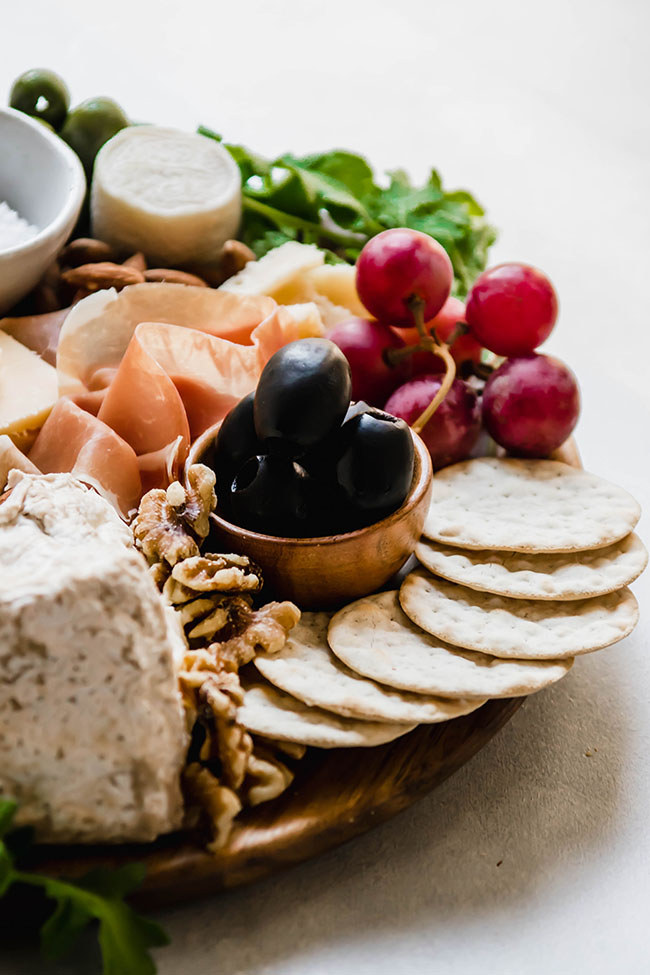
How much cheese do I need?
If you're serving a cheese plate as an appetizer, plan to have 2-3 oz. of cheese per person. If you're serving a lot of accompaniments (like charcuterie, crackers, and fruit) alongside the cheese, people will eat a little less cheese. Fewer accompaniments? Plan for people to eat a little more.
If you're making a cheese plate for dinner (*raises own hand*) plan for 4-5 oz. of cheese per person and load that plate up with plenty of fruits and veggies (because, y'know, BALANCE).
And here's the thing: If you or your party guests aren't big cheese eaters, you don't need as much cheese. If you're hosting a contingent of CHEESE. PEOPLE., you might want to stock up.
If you're worried you have too much cheese, cut all of your cheeses in half and put out one half at a time - you can always take the rest out later if you need it! Having a little extra cheese in the fridge for later is never a bad thing. Worried you don't have enough? Cut hard cheeses into extra-small pieces, spread each cheese out over a few different spots on the cheese board, and add plenty of extra fruit, nuts, and crackers.
(For reference, the cheese plate we made for these photos served about 10 people as an appetizer. We put out some extra crackers, crostini, and charcuterie halfway through, but we ended up with just the right amount of cheese).

Make a cheese plate on a budget
Cheese is DELICIOUS, but it can also get EXPENSIVE. Here are a few wallet-friendly shortcuts I like to take when I'm building a cheese plate on a budget.
- Pare down the number of items on the plate. It's definitely FUN to have five different cheeses on a plate, but it's not NECESSARY. If you're on a budget, choose just one or two cheeses. Cut them into pieces and put each cheese in multiple places on the board so that it still looks full and delicious!
- Skip the fancy stuff. You don't need a bunch of super-fancy (read: EXPENSIVE) cheeses on your plate for it to be a hit. There are plenty of cheeses that taste great and won't break the bank. Aldi has a great, budget-friendly selection, and Vermont Creamery makes amazing goat cheeses at low price points.
- Get the cheap crackers. If you're going to spend money on anything for a cheese plate, it should be the cheese. Don't worry about $4-a-box packs of 20 crackers if you're on a budget - grab some Ritz or Wheat Thins and call it a day. (I promise no one will mind!) If you can find a cheap baguette at your grocery store (we can usually get them for $2-$4) grab one of those and slice it into thin pieces to stretch it out.
- Skip the nuts. Nuts can get pricey. Around here, peanuts tend to be the cheapest variety to buy, but shave some money off your bill by skipping the nuts altogether and filling those spaces with extra arugula or in-season fruit.
- Shop in season. It's almost always cheaper to buy fruits and veggies when they're in season!
- Go light on the charcuterie, or skip it altogether. Aside from cheese, meat can be one of the most expensive parts of a cheese and charcuterie plate. If I'm on a budget but want some extra protein, I'll hit the deli counter and get some simple deli salami and sliced ham or turkey. I'm also usually happy to skip the meat entirely and add some extra fruit or crackers to round out the plate.
- I love examples. SO. IF I HAD $25 TO MAKE A CHEESE PLATE FOR 10 PEOPLE, HERE'S WHAT I'D GET:
- Vermont Creamery Goat Cheese Log ($7-ish for 8 oz. at my store)
- Grocery store variety sharp white cheddar cheese ($7-ish for 32 oz. at my store - I've also seen good white cheddar at Aldi for a good price)
- ¼ lb. Deli salami ($2-ish)
- 1 baguette ($2.50)
- ½ cup walnuts (from the baking aisle or bulk foods section - ½ cup usually runs me $3.50ish)
- Bag of arugula ($3 - and I'd maybe dress it with a splash of olive oil and lemon juice plus salt + pepper to give it some extra pizzazz)
- TOTAL: $25 (or $2.50 a person. Not too shabby!)
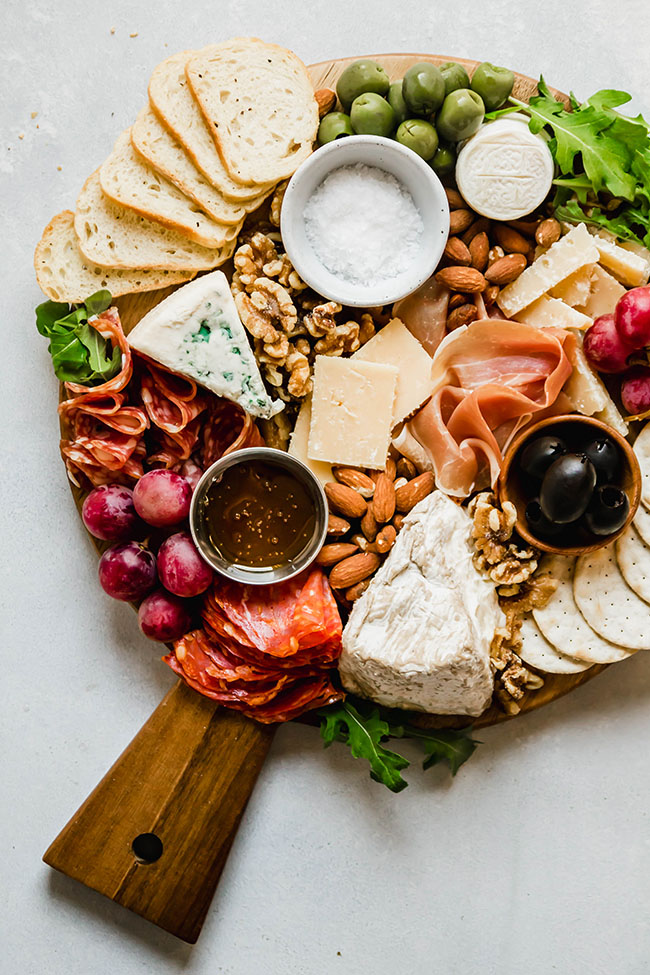
General tips to make a great cheese board
- Use a large, flat board. You don't need anything fancy - a plain cutting board will do! You just want to make sure it's big enough to fit everything comfortably. For these photos, we used a circular wooden cutting board (similar one here) but I also frequently make cheese plates on large plastic cutting boards, serving platters, or even spread out across a few dinner plates. You definitely don't need to run out and buy something brand new just for cheese boards. You're going to cover your board up anyway, so don't worry if it doesn't look perfect!
- Prep your cheese plate ahead of time. You can assemble a cheese plate in 10-20 minutes (easy peasy!) but if you'd like to do some prep in advance, try these ideas:
- Set out your cutting board/plate and arrange any small bowls the night before. You can also set out any containers of nuts, salt, or honey you're planning to use so they're ready to go.
- Assemble the cheese plate a few hours early, cover with reusable beeswax wrap or plastic wrap, and stick it back in the fridge (just make sure to take it out at least half an hour before you need it so the cheese can come to room temperature!) If you do this, I recommend adding any nuts or greenery at the last minute to preserve texture.
- Cut any hard cheeses ahead of time and store them in a container in the fridge until you're ready to use them (I like wrapping cut cheese in beeswax wrap or throwing it in a glass storage container).
- Keep your cheese plate fresh. If I know a cheese plate will be sitting out for awhile, I like to put the cheese out in waves. If I have one board, I'll put half the ingredients out at first, and then replenish after an hour or so. I'll also sometimes make two smaller, identical cheese boards, and keep the second one in the fridge until the first one is close to running out. It's also easy to toss some more crackers or nuts onto a cheese plate, so don't worry about putting every single thing out at once! If I have a bunch of guests over (like at Thanksgiving or Christmas) I'll even assign someone the job of "cheese plate replenisher" and show them where everything is so they can add to the cheese plate if it starts running low.
- You do you. At the end of the day, it's your cheese plate - and it should look and taste the way YOU want it to! I love building super-duper full cheese plates (like the one in these photos) because they're more fun to look at. If you'd like a little more room to maneuver, though, feel free to space out the cheeses and accompaniments to leave more space between each item! There's also no shame in throwing the guidelines out the window and sticking to your tried-and-true favorites (I've been known to make the occasional all-goat-cheese cheese plate. You gotta do what you gotta do).
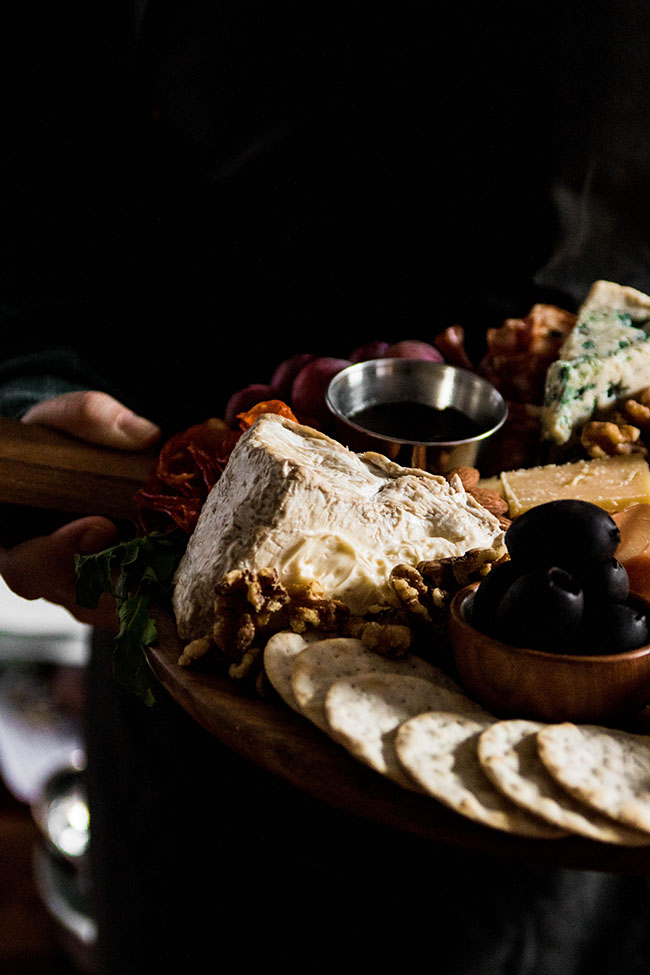
VIDEO: HOW TO MAKE A CHEESE PLATE STEP-BY-STEP
📖 Recipe
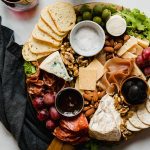
How to Make a Cheese Plate
- Prep Time: 20 min
- Cook Time: 30 min
- Total Time: 50 minutes
- Yield: Serves 6-10 as an appetizer
- Category: Appetizer
- Cuisine: American
Description
All the ingredients you need to build the ultimate cheese plate appetizer.
Ingredients
Use this list as a general guide - these are the ingredients we used to build this exact cheese plate, but don't be afraid to mix it up using your favorite snacks and cheeses or anything you have on hand!
CHEESES
- Blue or Gorgonzola Cheese
- Goat Cheese (I used a Bijou aged goat cheese from Vermont Creamery)
- Sharp White Cheddar Cheese (I used a Kerrygold aged cheddar)
- Brie
- Parmigiano Reggiano
NUTS
- Almonds
- Walnuts
CRACKERS & CROSTINI
- Toasted baguette slices with salt and pepper (crostini)
- Water crackers (we used these crackers from Carr)
MEATS & CHARCUTERIE
- Sliced salami
- Sliced soppressata
- Prosciutto
OTHER ACCOMPANIMENTS
- Black & Green olives
- Honey
- Flakey Sea Salt (we used Maldon Salt here!)
- Red Grapes
- Fresh arugula, for garnish
Instructions
- Take cheese out of the fridge and let it come to room temperature for 30 minutes to 1 hour (cheese should be served at room temperature!)
- Follow the step-by-step photos in this post to assemble all ingredients on a large cutting board or platter. Enjoy!
Notes
Equipment. I love a nice wooden cutting board for my cheese plates, but use whatever you have on hand! A plastic cutting board or large dinner plate works just fine. Use a few butter spreaders or fun cheese knives to serve.
Nutrition
- Serving Size:
- Calories: 506
- Sugar: 9.1 g
- Sodium: 2552.8 mg
- Fat: 25.6 g
- Carbohydrates: 51 g
- Protein: 19.7 g
- Cholesterol: 41.6 mg
Keywords: easy, appetizer, artisan
Nutrition facts are approximate and will vary widely by brand and depending on the amount of each ingredient you use. The nutrition facts above are approximated for the following amounts of the ingredients listed in the recipe card above: 3 ounces of each cheese, ¼ cup of each nut and accompaniment, ¼ pound of each meat, 1 700-gram baguette, and 24 water crackers.



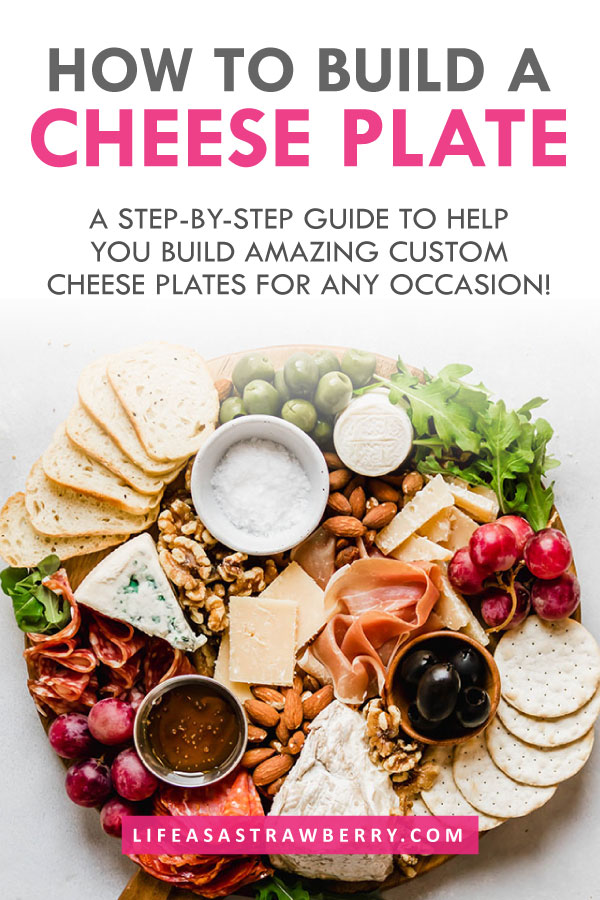
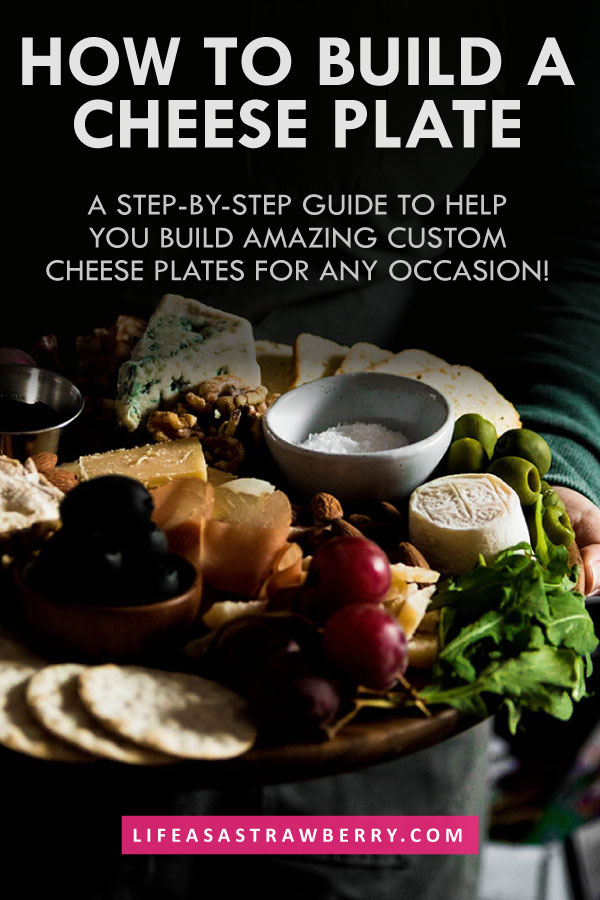
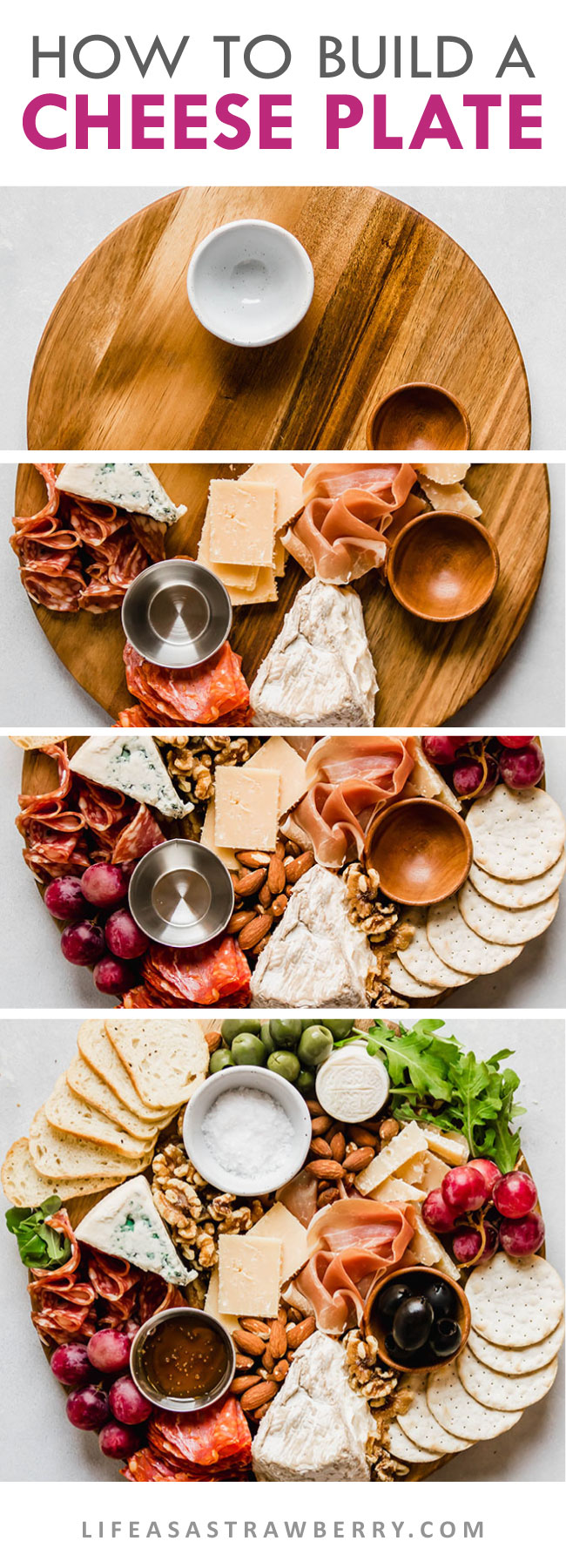

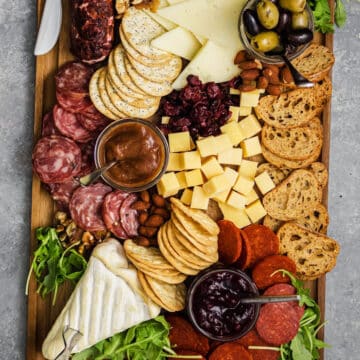
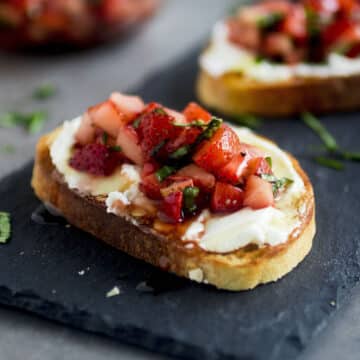

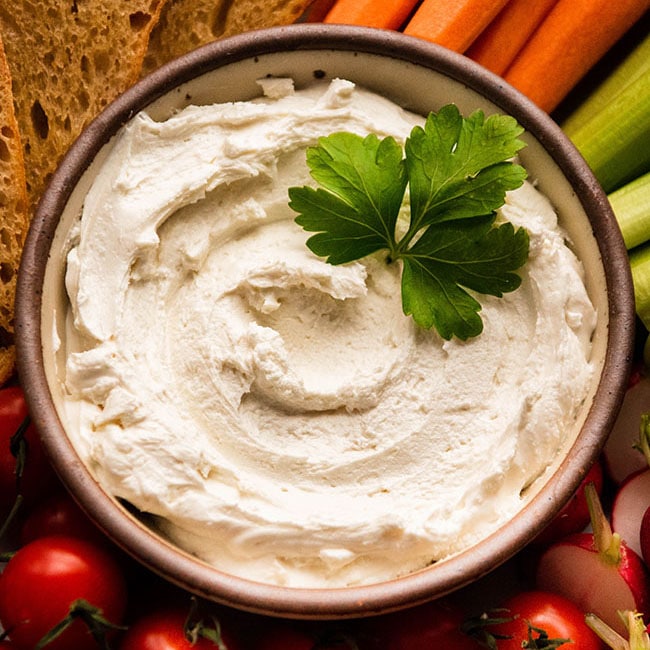
Rebecca
Excellent tips! Love it! Do you put crackers on the plate and then put in fridge or add the crackers when you set it up?
Team Life As A Strawberry
We're so happy you found this post helpful! We recommend putting the crackers and bread on the plate just before serving to maintain their crispy texture!
Sarah
Thank you for this!! The budgeting examples are especially helpful!
★★★★★
Team Life As A Strawberry
We're SO happy this post was helpful!
Emma Pomare
Beautiful, thank you for sharing
Team Life As A Strawberry
We're so happy you enjoyed it!
Carla
This is the first article I am reading about a cheese plate and I surely don’t need to read anything else! Thanks for the details, descriptions, options, recommendations and easy-peasy ensamble!! .. I will try it for my next party!
Team Life As A Strawberry
WAHOO! Thanks so much, Carla!
Salvina Portelli
Amazing everyone liked it,I followed every bit of your recipe.
Thank you .
Team Life As A Strawberry
WAHOO! We're so happy you enjoyed it!
Sarah
This is so in-depth and fantastic ! Thank you x
★★★★★
Team Life As A Strawberry
We're so happy you enjoyed it!
Joan Notes
Great suggestions easy to understand explanatios,excellent pictures extremely helpful and one can use their imagination. Perfect go to and keep it handy
★★★★★
Team Life As A Strawberry
WAHOO! We're so happy to be an inspiration for the perfect cheese plate!
Kikeena
The best article on plating a cheese board I've ever seen. Thanks for your level of detail and easy to follow directions. I'll follow this advice closely.
★★★★★
Team Life As A Strawberry
We're SO happy you found this post to be helpful!
Lauren
I love making cheese platters and I love coming to this page for inspiration!
★★★★★
Team Life As A Strawberry
YAY! We're so happy to be able to inspire you!
Beth valdez
can u send me e mail how to make a cheese platter cuz its my first time to do it... or other recipes just send me by e mail. Tnxs..😀
Team Life As A Strawberry
Hi Beth! At the bottom of our homepage you can sign up for the e-newsletter to get recipes and news in your inbox!